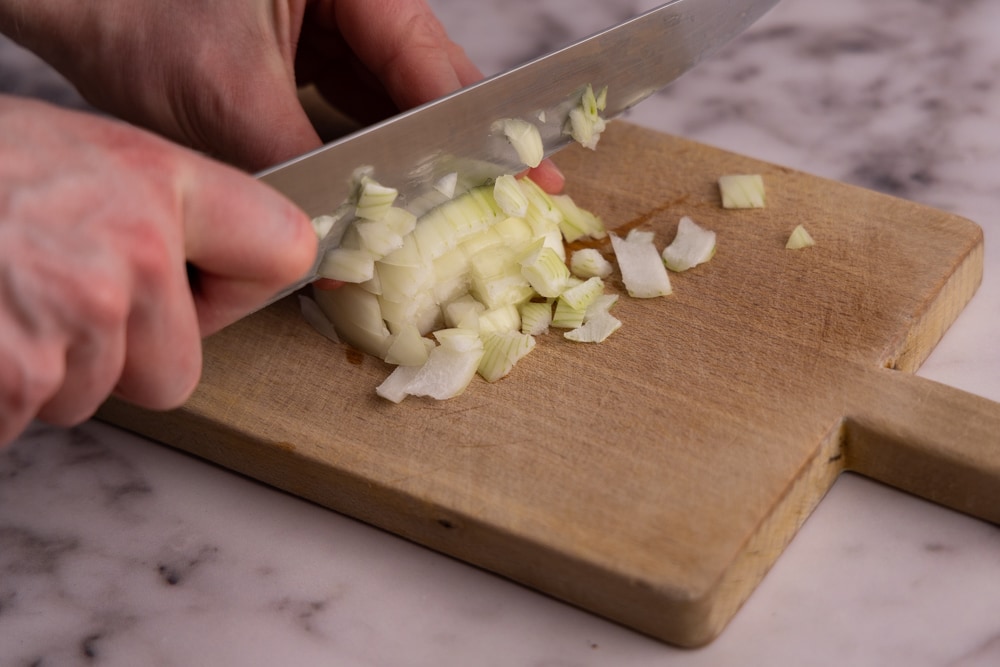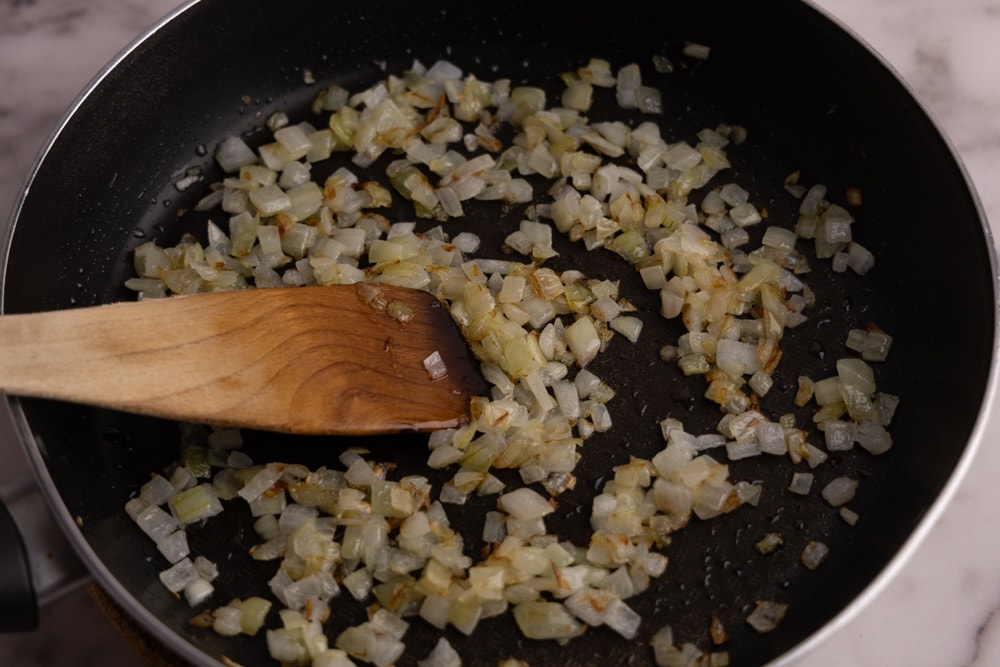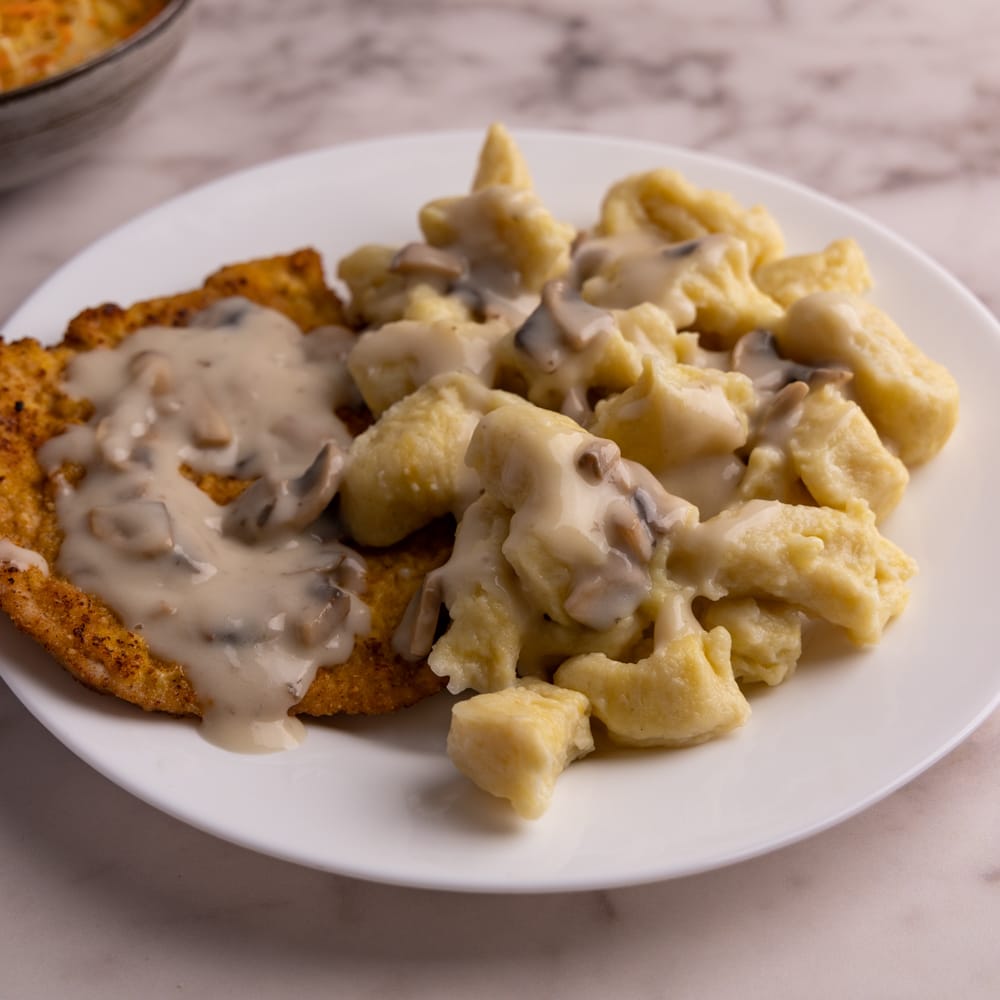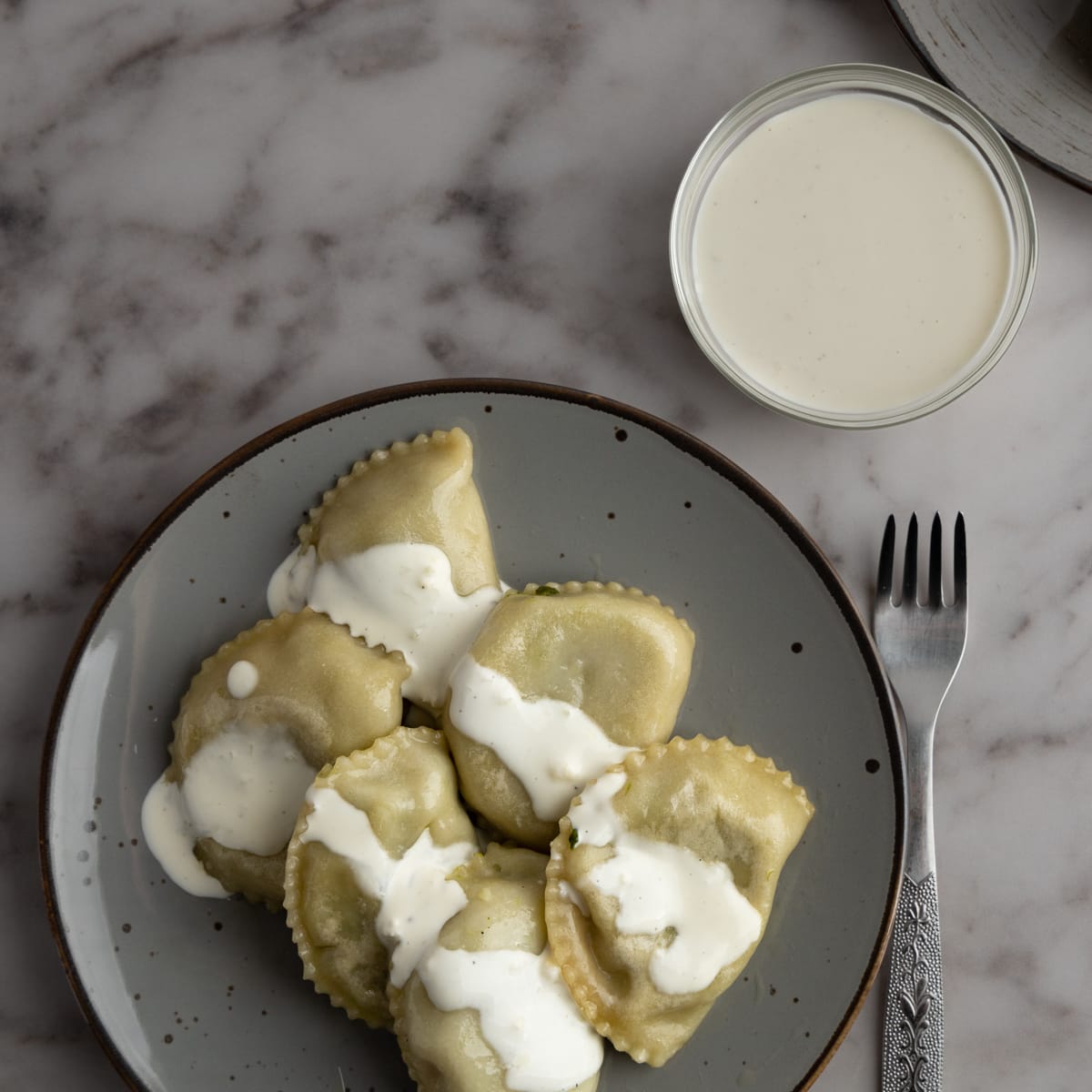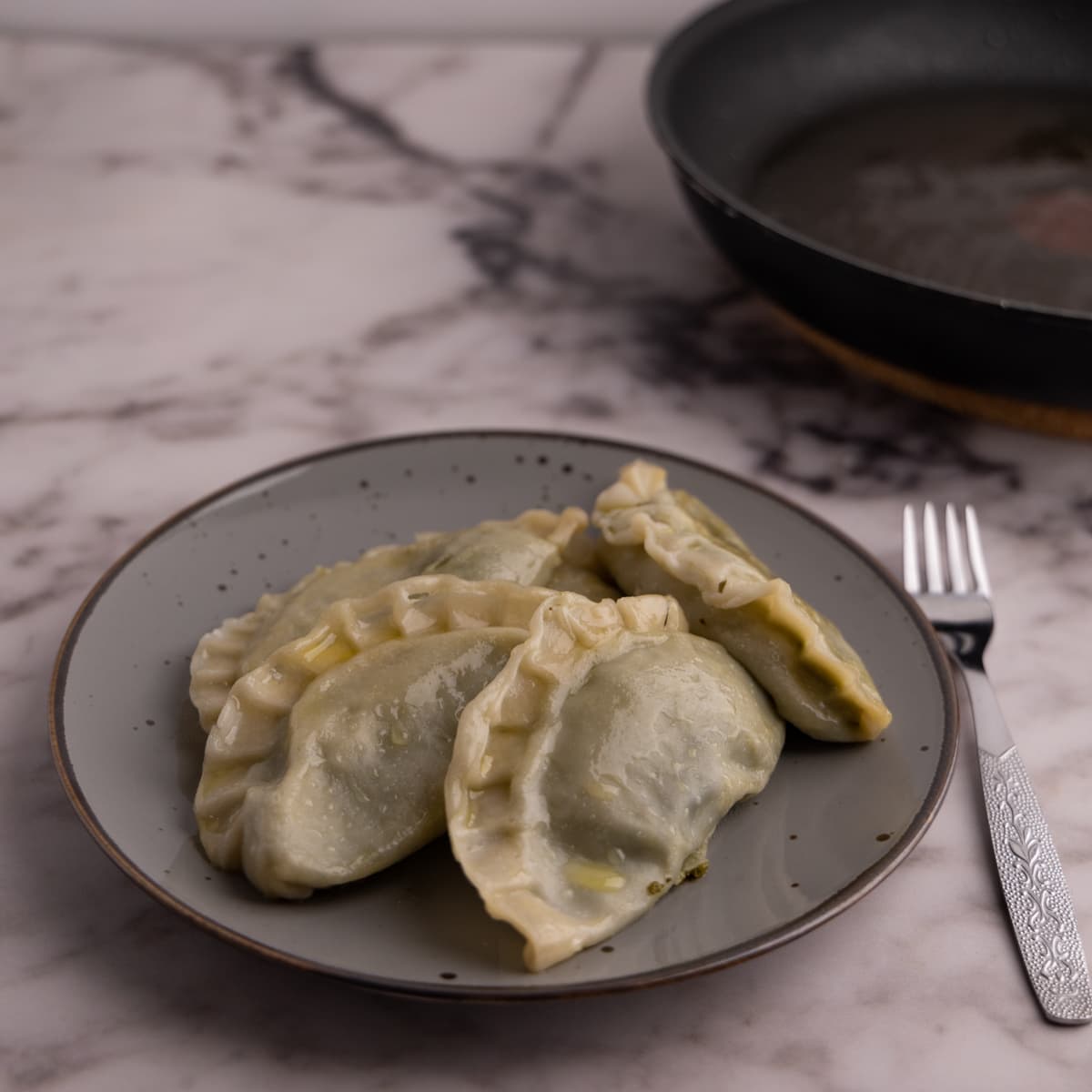Polish Meat Pierogi Recipe
When it comes to comfort food, few dishes can match the savory delight of meat pierogi. These plump pockets of dough filled with spiced ground meat are a staple of Polish cuisine, but have also gained a devoted following around the world.
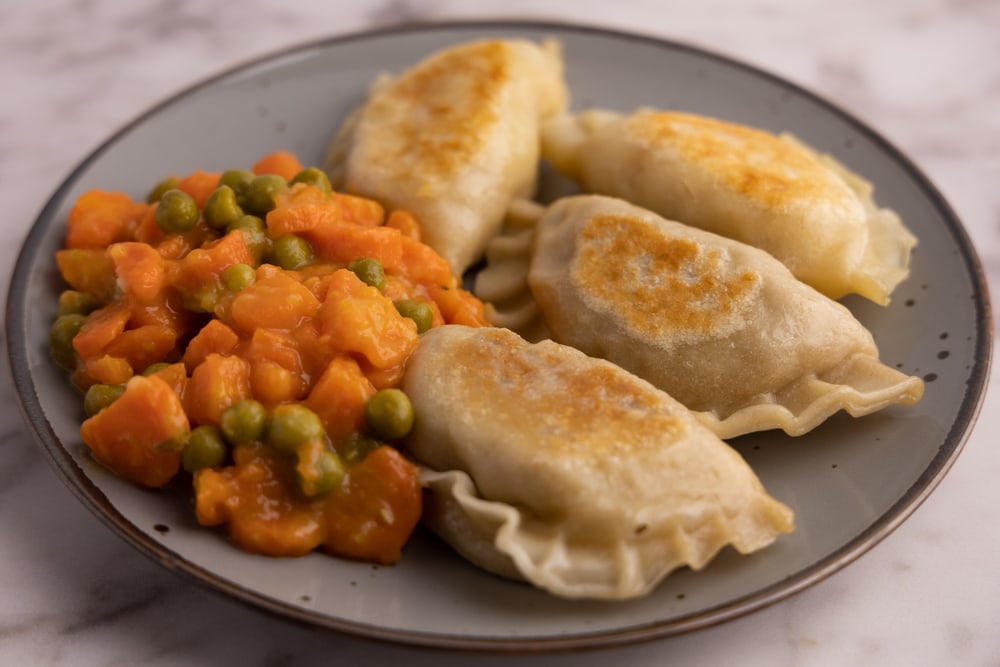
Polish cuisine is renowned for its hearty meat dishes, and meat pierogi are a prime example. These delicious dumplings can be filled with various meats and seasonings, making them a popular choice among meat lovers in Poland and beyond.
While making meat pierogi requires some time and effort, the recipe itself is straightforward.
However, you should plan to spend at least two hours cooking the pierogi. Preparing the dough, the filling, and filling and cooking the pierogi takes at least that long, at least in my experience.
For this reason, many people prefer to make pierogi on weekends and store them for later use during the week. This way, you can enjoy a delicious, homemade meal even when you’re short on time.
(Polish lazy pierogi are a much better option for a busy weeknight, as they only take 30 minutes to whip.)
If you’re making meat pierogi for the first time, read the ingredients notes, step-by-step instructions, and tips. If you’re a veteran, feel free to jump to the recipe card.
First time making pierogi? Check out our guide to homemade pierogi to learn everything you need to know about the process.
Ingredients Notes and Substitutes
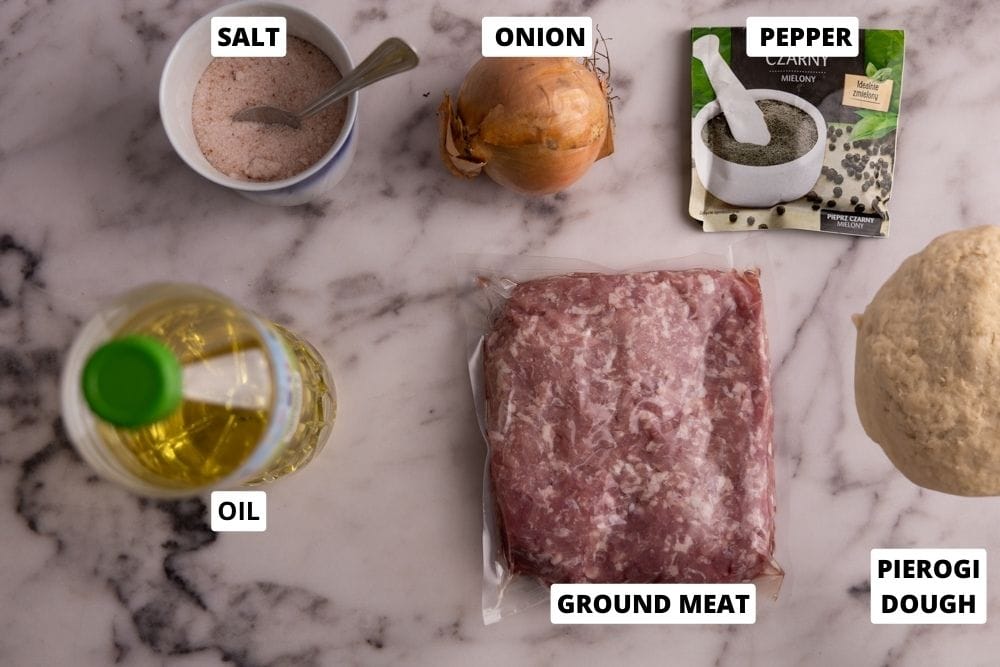
- Pierogi dough. You’ll need one portion of my best pierogi dough to cook these meat pierogi. Alternatively, you can use another recipe if you have a favorite one already. Just make sure you use about two cups of flour to have enough dough to wrap all the meat filling.
- Meat. Traditionally, ground pork is used in Polish meat pierogi, but you can use any other ground meat of your choice. I discuss this in more detail in the section on variations, but the key is choosing the meat you like and adjusting the seasoning accordingly.
- Spices. I use fine-grained salt and black pepper to season the meat, but you can use other types of salt or your favorite spice mix. The goal is to ensure that the meat filling is flavorful and well-seasoned.
- Onion. Adding onion to the meat filling can help enhance the flavor of your pierogi. While I typically use yellow onions, you can also use red onions or shallots. You can also skip it, but keep in mind that the overall flavor of your pierogi may be slightly different.
- Fat. I use regular cooking oil, but you might as well go with ghee or butter. If you like cooking meat using olive oil, that’s fine too.
- Egg. A single egg helps bind the filling together, but you can skip it with little difference in overall quality.
Step-By-Step Instructions
- Prepare the dough. Use my best pierogi dough recipe, or go with your favorite one. Since I recommend letting the dough rest for 30 minutes before using, it’s best to start by preparing it.
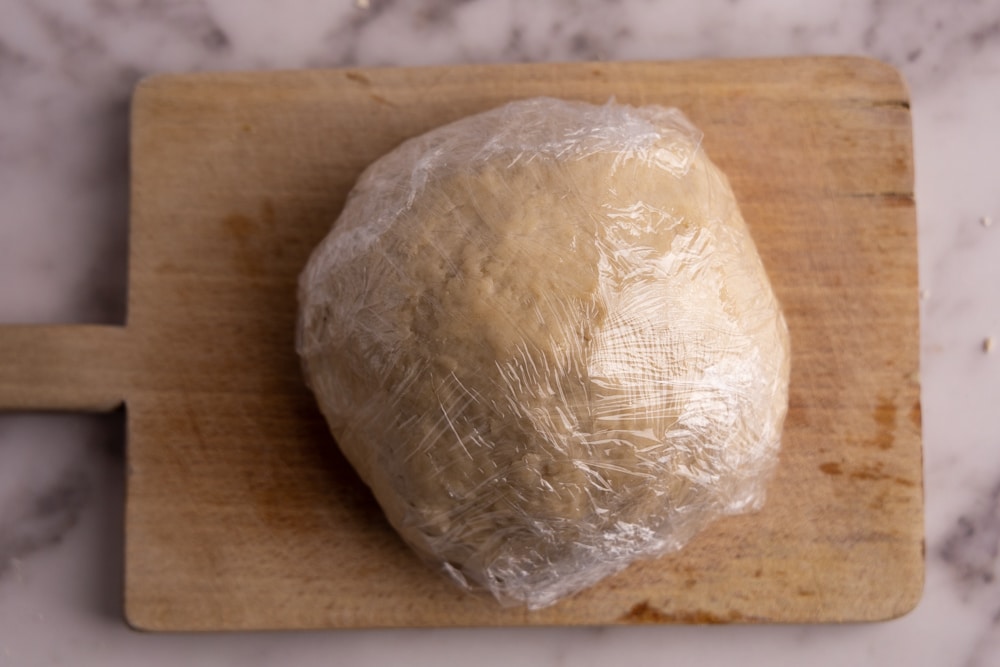
- Peel and chop an onion, then sautee it with a few tablespoons of oil on a warmed-up non-stick skillet for 6 to 10 minutes, until soft and cooked through.
- Add the ground meat, break it down using a wooden spoon, and add the spices. Cook until the meat is browned.
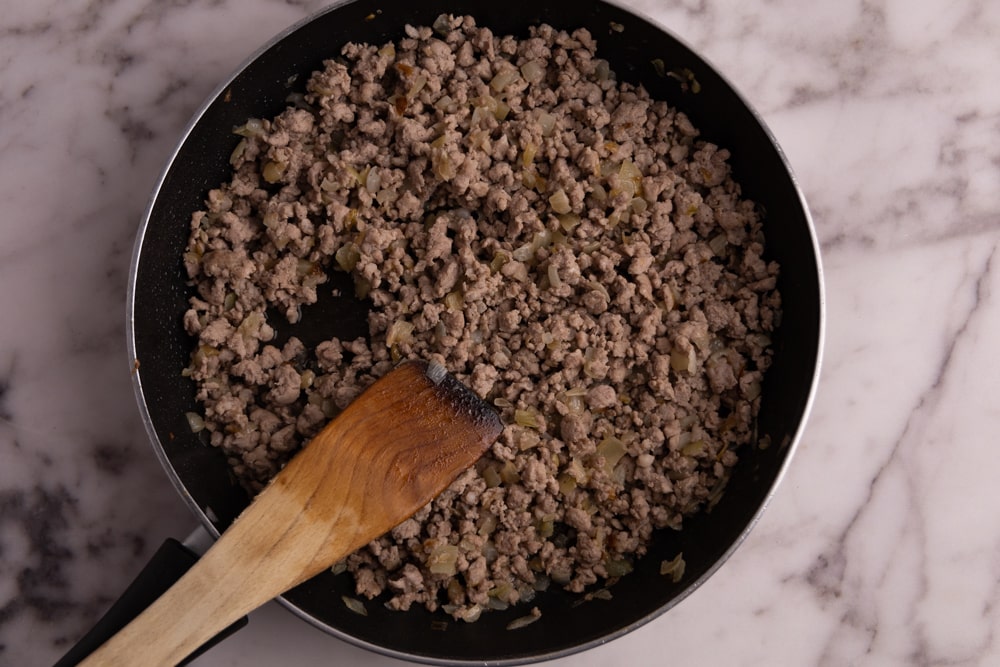
- Taste and adjust. Once the meat is cooked, taste it and add more spices if needed. You want it to taste great before going any further.
- After cooking and seasoning, give the meat a couple of minutes to cool down a bit. Then stir in a whisked egg that will help bind everything together. That short cooldown period is there so that the egg doesn’t cook immediately when you add it.
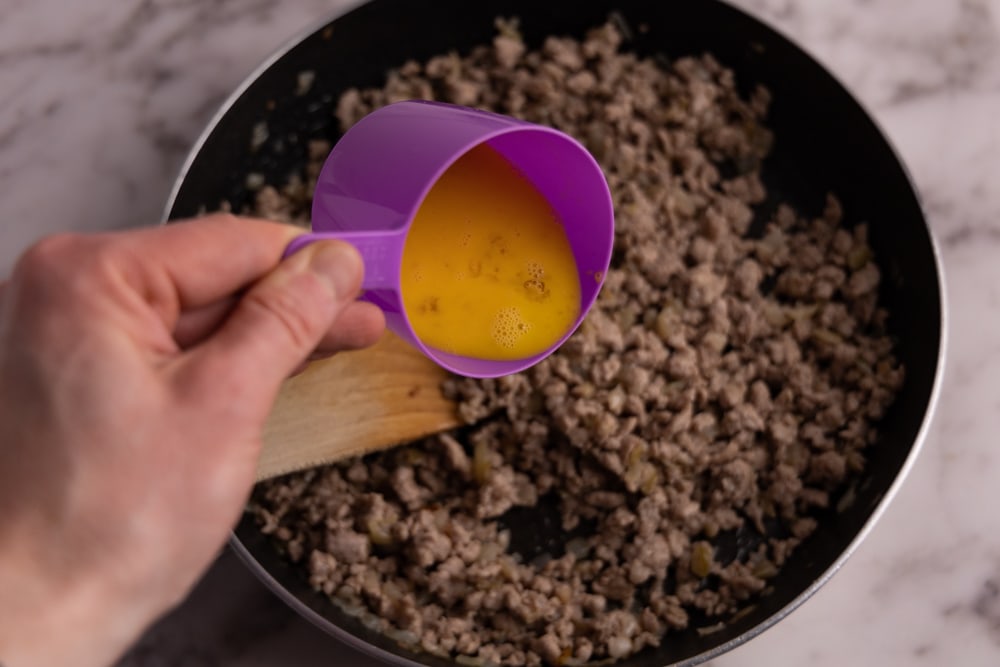
- Grind the prepared filling. Grab a meat grinder, food processor, or blender, and grind the meat into a paste. Don’t skip the step, as the grinding process is what transforms grainy cooked meat into a paste that works great as pierogi filling. I typically use a blender for that, as it requires the least cleanup, but if you don’t have one that’s powerful enough, you’ll probably have to use a food processor or dust off that meat grinder.

- Divide the pierogi dough into two or three parts. Take one part and spread it on a floured work surface, then roll it out until it’s nice and thin. Be careful not to roll it too thin, as it may tear when you form the pockets and seal the dough around the filling. Wrap the rest of the dough tightly to prevent it from drying out.
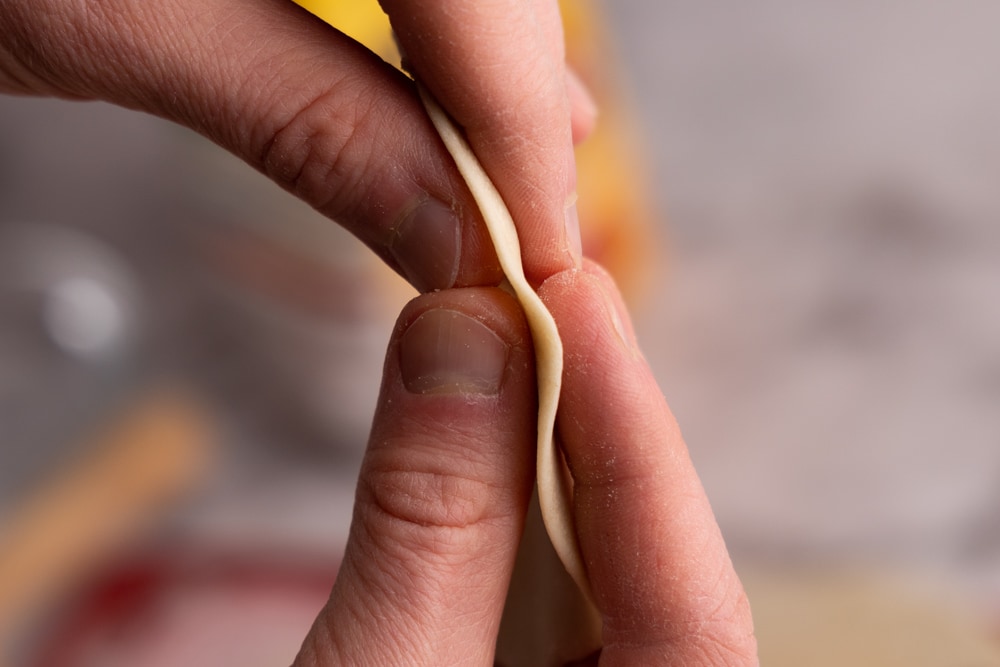
- Cut palm-sized circles in the rolled pierogi dough. Anything round with a somewhat sharp edge is great, but a simple glass or mason jar works as well. Or use your pierogi maker if you have one. Form a ball with the dough left over after cutting and use it when rolling out the rest of the pierogi.

- Place a spoonful of the filling in the middle of the dough circle, then fold the dough over the filling and press the edges together starting in the middle. Try to leave as little air as possible in the pocket you’re forming. To make a good seal, moisten the outer edge of the dough using a wet finger before pressing the edges together.
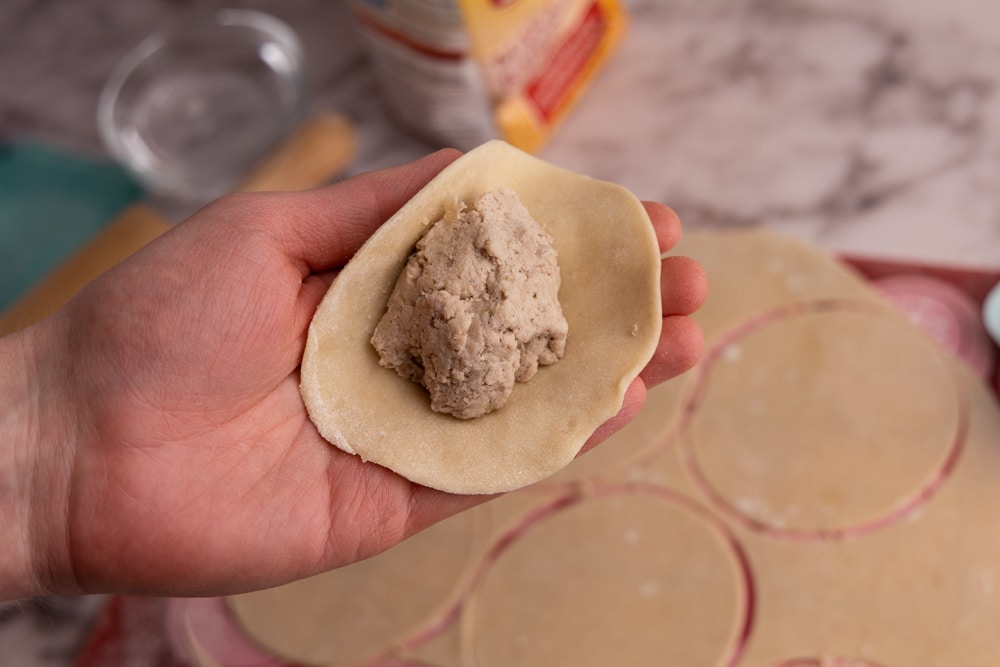 Add the filling
Add the filling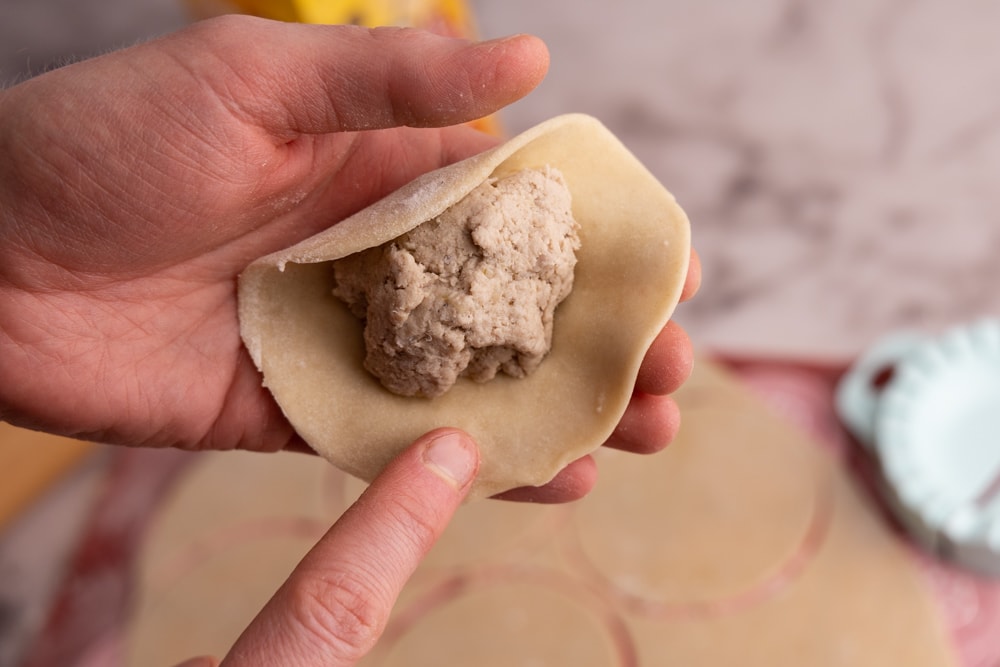 Moisten the dough edges using a wet finger
Moisten the dough edges using a wet finger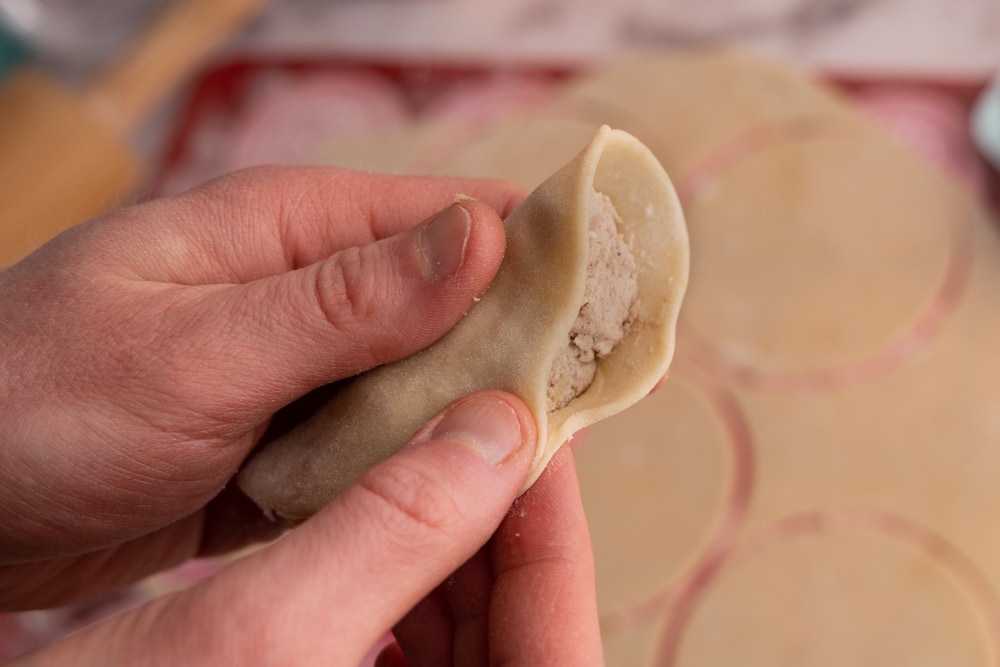 Seal
Seal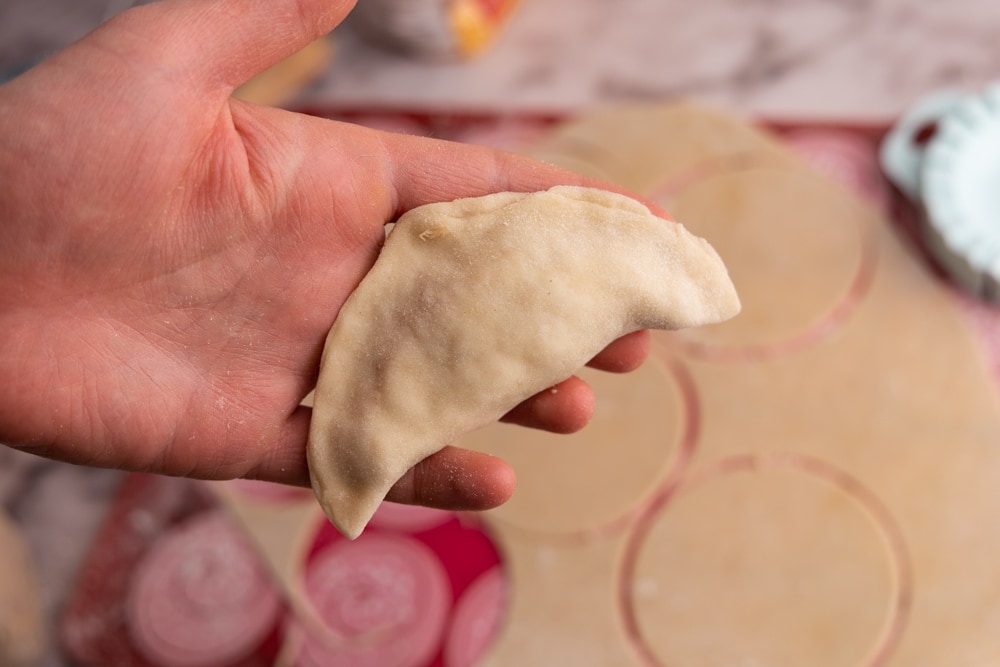 A hand-formed pierogi. Not the prettiest, but tasted great.
A hand-formed pierogi. Not the prettiest, but tasted great.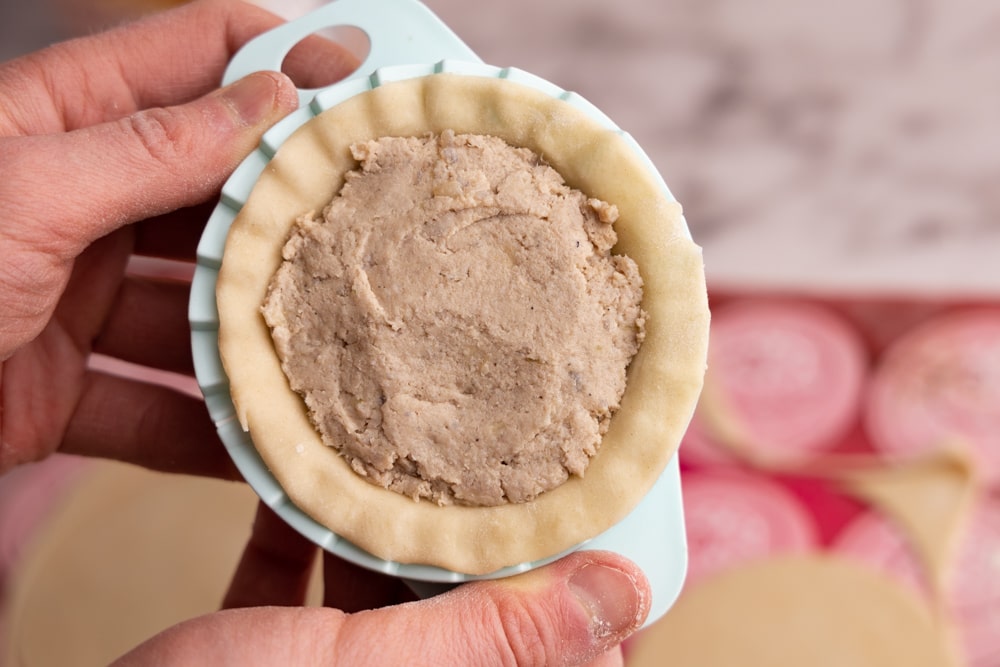 Or use a pierogi maker
Or use a pierogi maker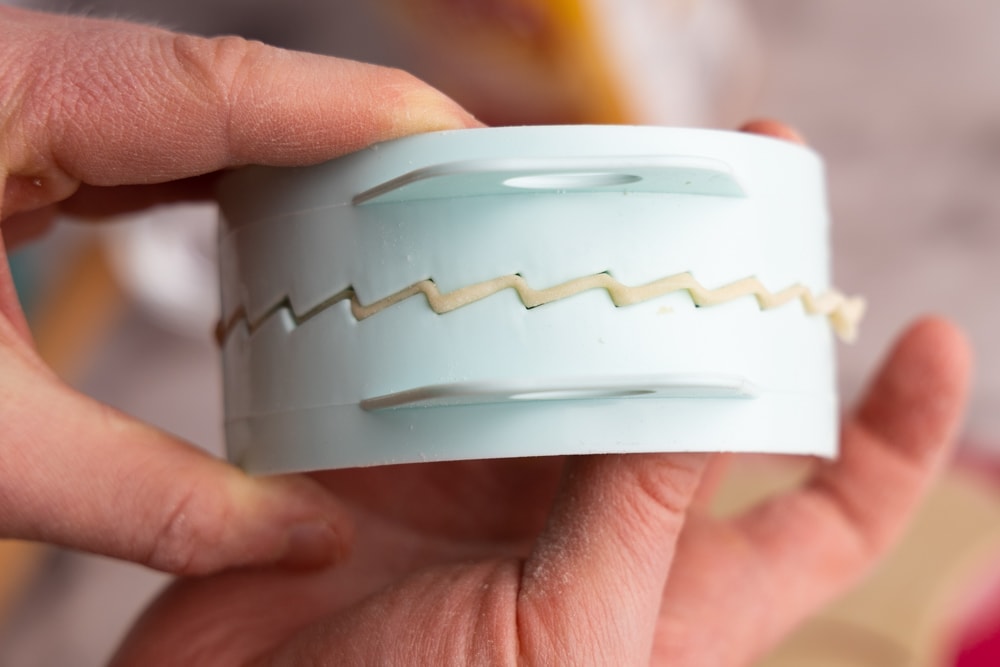
- Place each formed pierogi on a floured cookie sheet and cover them with a damp kitchen towel. The edges will dry out quickly otherwise. If you want to save space and let the pierogi touch each other, lightly brush the areas where they’ll touch with flour. This will prevent them from sticking together and causing the pierogi dough to tear when removed for boiling.
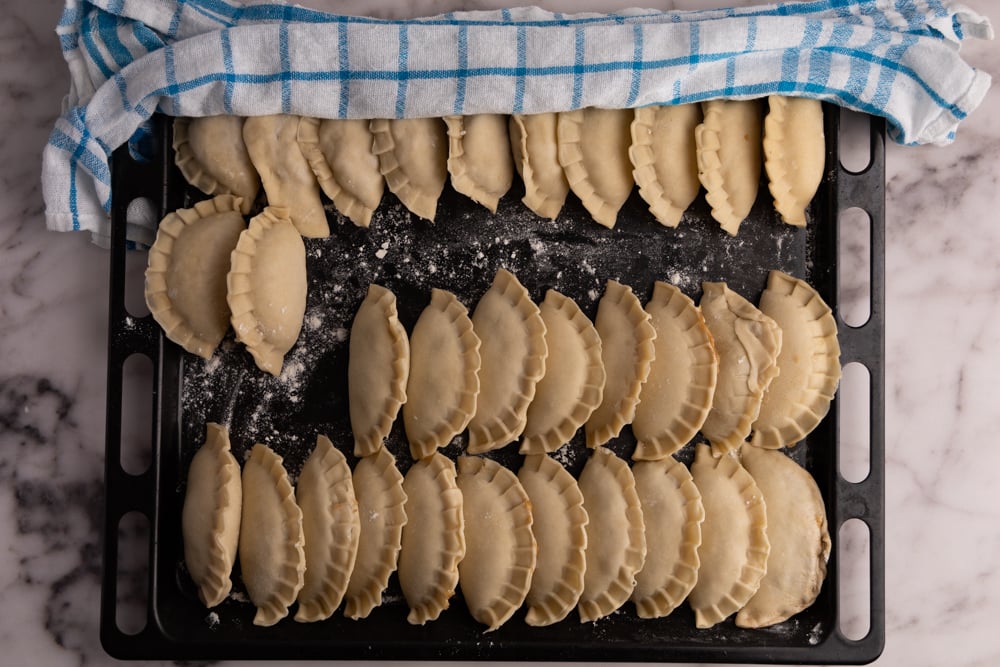
- Continue forming pierogi until you run out of dough or filling.
- Bring a large pot of salted water to a boil. I typically use one teaspoon of salt per quart of water but feel free to adjust the amount to your preferences.
- Once the water is boiling, add a few pierogi to the pot and stir them to prevent them from sticking to the bottom. Once the pierogi start floating to the surface, simmer them gently for another 3 to 4 minutes. Make sure not to overcrowd the pot so that the pierogi don’t stick together or cook unevenly.

- Remove the pierogi from the water using a slotted spoon and serve.
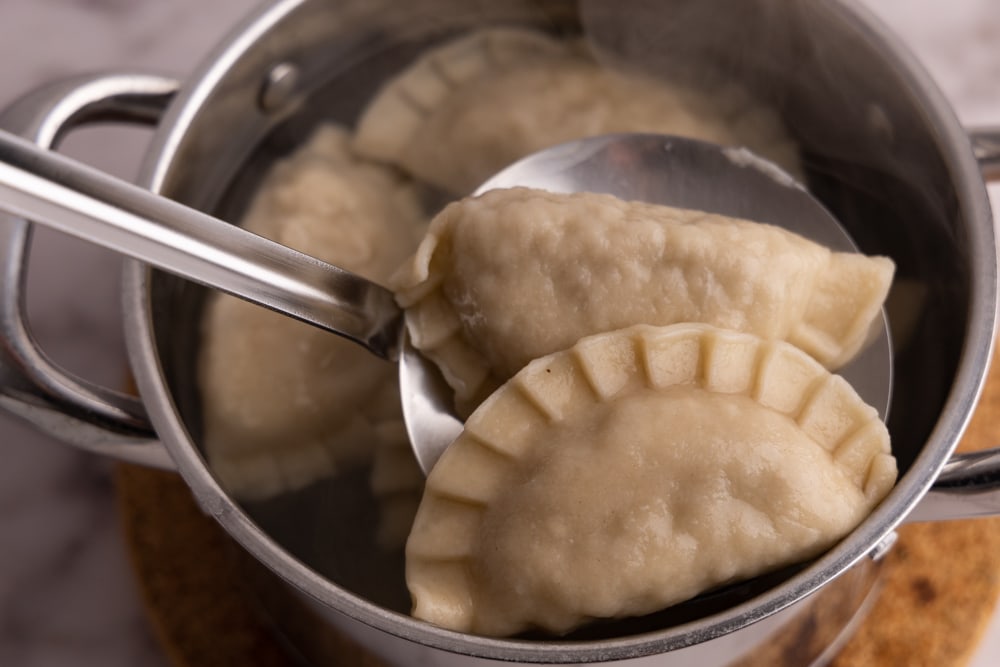
Recipe Tips
- Season the meat filling well and taste it before stirring in the egg. Adjust the seasoning as needed to ensure a delicious filling.
- Limit fat. When cooking the onion and ground meat, limit the amount of oil or butter you use to a minimum. You want the meat mixture to be fairly dry, not greasy. The same applies if you’re cooking onions to top your pierogi.
- Consider making a larger batch of pierogi by doubling the dough and stuffing or using a different pierogi filling (e.g., spinach pierogi, lentil pierogi, asparagus pierogi, or apple pierogi) for the second half of the dough to save time on future meals. Keep in mind that making pierogi is a time-consuming process, so it’s worthwhile to make the most of your effort.
- For an extra burst of flavor and texture, try pan-frying the pierogi after boiling them until they’re lightly browned on both sides.
- Give the pierogi some time to rest and let the flavors meld. They taste even better the next day after the flavors have had time to intensify.
- If the filling seems too soft to work with, refrigerate it for at least an hour before using it. This will help it firm up and make shaping and filling the pierogi easier. I typically prep the filling the day before I cook the pierogi and refrigerate it overnight.
- Make sure to have a small bowl of water nearby when forming the pierogi. That water will allow you to quickly moisten the outer edge of the dough, helping it stick better.
- There will be leftover dough or filling when making pierogi. That’s the nature of the beast. The amount of dough and filling required depends on various factors, making it difficult to provide exact measurements. If there is a large amount of leftover dough, you can freeze it for later use. But if there’s only enough for a few pierogi, you can discard it. For the leftover filling, I recommend freezing it and using it when making the next batch of pierogi.
- Start boiling the water after you’ve used about half of the filling, and start cooking the pierogi as soon as it boils. Drop a few pierogi into the pot, give them a stir, and continue rolling the dough and forming the pockets, checking how the cooking pierogi are doing every minute or so.
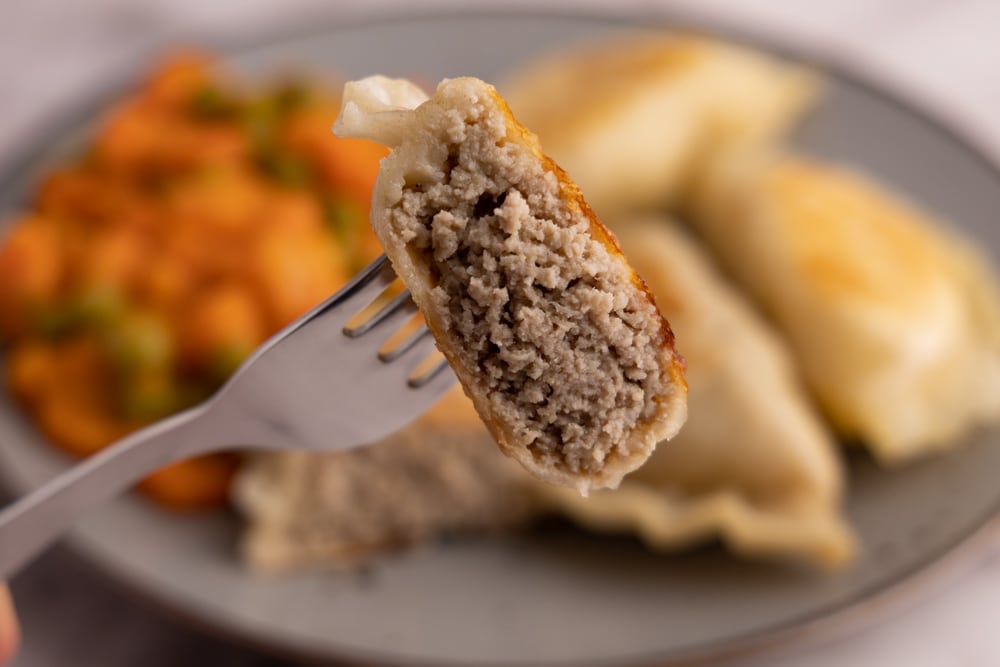
Variations
Although traditional Polish meat pierogi are filled with ground pork, you can use any ground meat you like to create your own unique flavor profile.
Popular options include beef, turkey, and chicken.
That said, keep in mind that different meats require different seasoning. So while a simple combination of salt and pepper may work well for most options, you can experiment with spices like curry powder for ground chicken or a taco seasoning mix for ground beef.
The possibilities are endless, and you can create countless variations of meat pierogi by mixing and matching different meats and spices. Just remember to taste the meat after cooking to ensure it’s well-seasoned and suits your taste preferences.
(By the way, these meat pierogi are quite similar to pelmeni, a type of Russian dumplings. The main differences are pelmeni are smaller and typically stuffed with raw meat, while meat pierogi are larger and the meat is cooked before you stuff it.)
What to Serve With Meat Pierogi
- Sautéed onions. In diners or when ordered for takeout, meat pierogi are typically served alone and topped with sautéed onions. Or you can top them with sour cream for some tang (read our guide to pierogi toppings for more ideas). That said, they can also serve as a meal’s “meat” component.
- Potatoes. Boiled or mashed potatoes are a popular side dish to meat pierogi in Poland. For a variation, you can also make Polish potato dumplings or cook a batch of potato and cheese pierogi.
- A salad. To complement the meat pierogi and potatoes, make a simple salad such as Polish cucumber salad, sauerkraut salad, or shredded carrots and apples.
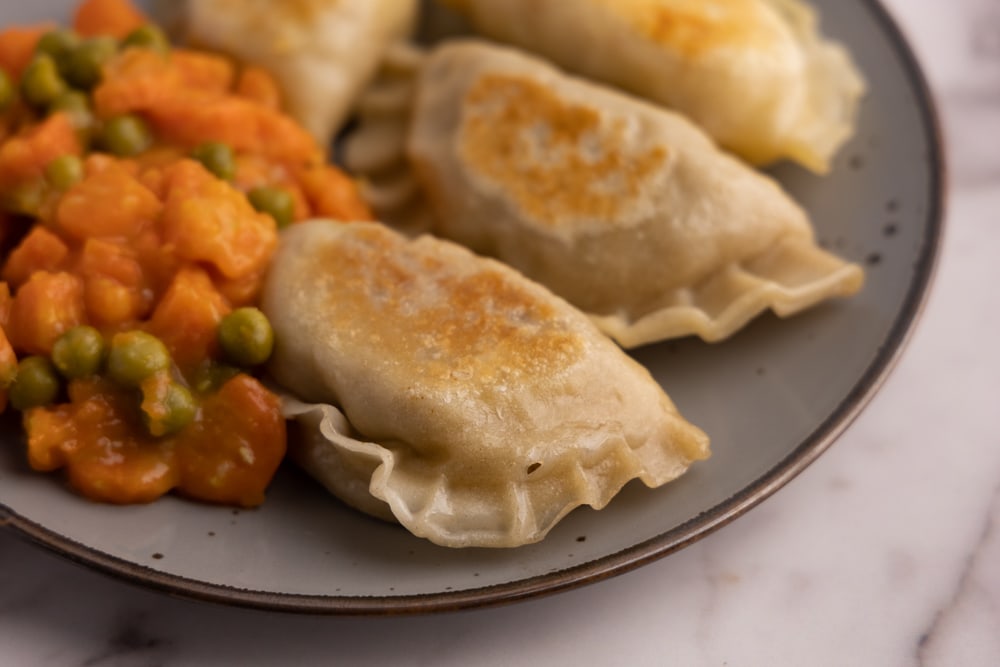
Storage
To store meat pierogi, let them cool and dry individually on large plates.
After 15 to 20 minutes, flip them over to ensure that both sides dry evenly. Once completely dry, transfer them to an airtight container, arranging them in a single layer and ensuring they are not touching each other too much (a bit is okay) to avoid sticking together.
If you need to stack the pierogi, separate each layer with parchment paper or plastic wrap.
Alternatively, you can freeze leftover pierogi for later use.
Reheat
To reheat meat pierogi, start by heating a non-stick skillet over medium-low heat and add a few tablespoons of butter or oil to thinly coat the surface of the skillet.
Once the skillet is preheated, add the pierogi to the skillet, making sure not to overcrowd the pan. Next, cover the pierogi with a lid and cook them for 12 to 15 minutes, flipping them halfway through to ensure they heat evenly.
Be sure to shake the skillet every couple of minutes to prevent the pierogi from sticking to the bottom.
For a crispier texture, increase the heat slightly or leave the pierogi on the skillet for a bit longer, flipping them only after one side is nicely browned.
Enjoy your hot and delicious pierogi!
Polish Meat Pierogi

Ingredients
- 1 batch pierogi dough
- 1 pound ground pork or any other ground meat ~450g
- 1 yellow onion large
- 4 tablespoons cooking oil
- ½ teaspoon salt
- ¼ teaspoon pepper
Instructions
- Prepare the pierogi dough using your favorite recipe or use the best pierogi dough recipe.
- Peel and chop an onion, and saute it with a few tablespoons of oil in a non-stick skillet over medium heat for 6 to 10 minutes until soft and cooked.
- Add the ground meat, salt, pepper, or any other spices that you like. Cook for 10-15 minutes until browned.
- Taste and adjust seasoning if needed.
- Let the meat cool down a bit, and then stir in a whisked egg to bind everything together.
- Grind the meat mixture in a food processor, meat grinder, or blender until it turns into a paste.
- Divide the pierogi dough into two or three parts. Then, spread one on a floured work surface and roll it out until it’s thin. It shouldn’t be super thin so that you can still stretch it when forming the pockets.
- Cut palm-sized circles in the rolled pierogi dough using a cookie cutter or glass.
- Place a spoonful of meat filling in the center of each dough circle. Fold the dough over the filling and press the edges together, starting in the middle. Leave as little air as possible in the pocket you’re forming. To help form a good seal, moisten the outer edge of the dough using a wet finger.
- Place each formed pierogi on a floured cookie sheet and cover them with a damp kitchen towel.
- Bring a large pot of salted water to a boil. I typically use one teaspoon of salt per quart of water but feel free to adjust the amount to your preferences.
- Once the water is boiling, add a few pierogi to the pot and stir them to prevent them from sticking to the bottom. Once the pierogi start floating to the surface, simmer them gently for another 3 to 4 minutes. Make sure not to overcrowd the pot so that the pierogi don’t stick together or cook unevenly.
- Remove the pierogi from the water using a slotted spoon and serve immediately with your favorite toppings.
